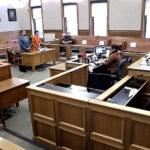In the past 12 months, the United States has narrowly avoided two terrorist plots directed against aviation. The first occurred last Christmas Day aboard a passenger plane in the skies above Detroit. In that instance, sheer luck and the quick actions of travelers and crew averted disaster. The second incident in October involved explosives concealed in air cargo shipments from Yemen and was thwarted following an intelligence tip from an American ally. In both cases, terrorists succeeded in getting explosive materials on board aircraft.
This week, the Senate Homeland Security Committee, on which I am Ranking Member, held a hearing on aviation security to consider the improvements that have been made and the ways in which we still remain vulnerable.
I asked the Transportation Security Administration (TSA) head, John Pistole, a fundamental question: If our nation had not received an intelligence tip about explosives hidden in air cargo that was shipped from Yemen, would our current security systems have detected these package bombs on October 28?
“My professional opinion, no,” Mr. Pistole replied.
That provided a chilling reality check. Despite efforts since September 11, 2001, to develop a dynamic, multi-layered aviation security system to thwart future attacks, we cannot rest and allow ourselves to be lulled into complacency — a response that our enemies would surely welcome.
In the two cases in the last year, we see the fanaticism, ingenuity, and patience of our enemies. We see the need to re-examine our priorities and ensure that our resources are properly deployed. These near-misses should increase our vigilance and provide yet another wake-up call.
This is the nature of the terrorist threat that we face. It is evolving and ever-changing. It finds weaknesses and exploits them.
Over the last year, TSA has rolled out new airport security procedures, including the use of full-body scanners and pat-downs conducted by TSA personnel. These new security measures are drawing heightened scrutiny as they affect everyone who flies.
Since 9/11, all air travelers have learned patience for the security screening process, which can bring degrees of inconvenience and awkwardness. As Administrator Pistole told our committee, if passengers were given the option to board two airplanes – one where fellow travelers had been fully screened and scrutinized and one where they had not – it is clear that almost every flyer would choose the former, and not the latter.
Like many Americans, however, I am concerned that privacy be protected and that new security methods are as respectful as possible. I have questioned the intrusiveness and possible negative health effects of the full-body scanners, or Advanced Imaging Technology (AIT) machines, some of which expose passengers to small amount of radiation.
During the hearing, I told Administrator Pistole that the TSA should consider adopting the AIT technology being used in the Netherlands. Using different software, those machines produce “Gumby-like,” featureless images of passengers and indicate with a red box where concealed material is located on the body. This technology does not use images that have physical details of the passenger’s body. In addition, this technology does not expose people to radiation.
I have written multiple letters to Homeland Security Secretary Janet Napolitano, urging her to look into the technology used at the Netherlands’ Schiphol Airport, where, earlier this year, I received a briefing on their machines, which were installed in the wake of the airport’s failure to detect the explosives on the Christmas Day terrorist. That technology is far less intrusive and is able to locate concealed weapons or hidden explosives on passengers. I also have asked that Secretary Napolitano convene an independent review panel to consider the health effects of the AIT being used at American airports.
There is a balance to be struck here. We must guard against excessive intrusion of privacy and ensure the use of devices that have been proven safe and effective.
If the public develops greater confidence in the privacy and safety of the machines, there will be fewer travelers who will opt out and have to undergo a time-consuming pat-down by TSA officials. Conducting these pat-downs diverts resources from other risks at the airports and slows the flow of passengers though airport checkpoints. Moreover, most passengers find them to be highly intrusive.
More effective use of screening resources should be a goal of not just passenger screening, but also for high-risk air cargo. Currently, air cargo manifest information is required to be submitted to DHS only four hours before that cargo arrives in the United States. That means the information is often transmitted to DHS while the aircraft is in the air – providing no opportunity to conduct further inspections of flagged cargo before departure. For DHS to conduct risk-based screening of cargo, it needs information in advance of a flight.
Indeed, DHS has acknowledged that the shipping information about the two packages from Yemen would have prompted the agency to flag them as high-risk upon arrival in the United States. We need a system to ensure that additional inspection occurs abroad. At the hearing, I pressed the Department to ensure that it develops mechanisms to obtain cargo information and conduct screening of high-risk cargo before it is loaded on planes bound for the United States.
DHS should continuously re-evaluate how the government can best focus its limited screening resources by focusing on the highest risk passengers and cargo, while facilitating the flow of legitimate passengers and commerce. The government should also seek to deploy the right mix of technology and techniques that are safe and effective and that minimize privacy concerns whenever possible. I will continue to press the Department of Homeland Security on these matters.
Presque Isle, ME
53
Rain
Houlton, ME
56
Rain
Caribou, ME
53
Rain
Fort Kent, ME
49
Rain
Change Location
- Presque Isle
- Houlton
- Caribou
- Fort Kent
© 2024 Bangor Publishing Company.








